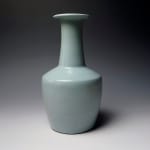Nakashima Hiroshi 中島 宏 1941-2018
H29.7 x Dia13.9 x Lip Dia8.8cm
Further images
-
(View a larger image of thumbnail 1
)

-
(View a larger image of thumbnail 2
)

-
(View a larger image of thumbnail 3
)

-
(View a larger image of thumbnail 4
)

-
(View a larger image of thumbnail 5
)

-
(View a larger image of thumbnail 6
)

-
(View a larger image of thumbnail 7
)

-
(View a larger image of thumbnail 8
)

-
(View a larger image of thumbnail 9
)

-
(View a larger image of thumbnail 10
)

Nakajima Hiroshi was designated for his use of celadon in 2007. His forms are inspired by Chinese metal vessels for which he selects the specific celadon tone to match the form. The two works in this exhibition have different forms and different glazes. Managing celadon with this level of specificity is truly challenging as it’s not an easy glaze to use. Nonetheless, Nakajima manages it and preserves this skill in Japan: truly the baseline for a Living National Treasure.
Nakajima’s glazes are historically grounded in Chinese Song dynasty celadon. His pieces are inspired by traditional Chinese metal receptacles, exemplified by an emphasis on the size and scale of vessels. In particular, he studied the forms of Han and Tang dynasty bronze objects from the archives of Japan’s national collections, which showcases an extensive history of Chinese archaeology. His interest in archaeology and history is reflected in his works. His deeply considered approach to form, glaze, and surface results in a grandeur that few contemporary celadon potters are able to achieve.
His commitment to tradition reveals a level of detail sought after by many contemporary celadon artists. In particular, his fired glazes took advantage of the thick viscosity that the iconic blue-green glaze offers. As a result, his forms are adorned with a textural sensitivity. Under different light, Nakajima’s vessels offer an undulating surface scape, wherein the craqueleur of his celadon seems to change the color of the glaze. The sea-green landscape of his regal forms shifts into an ocean blue.









